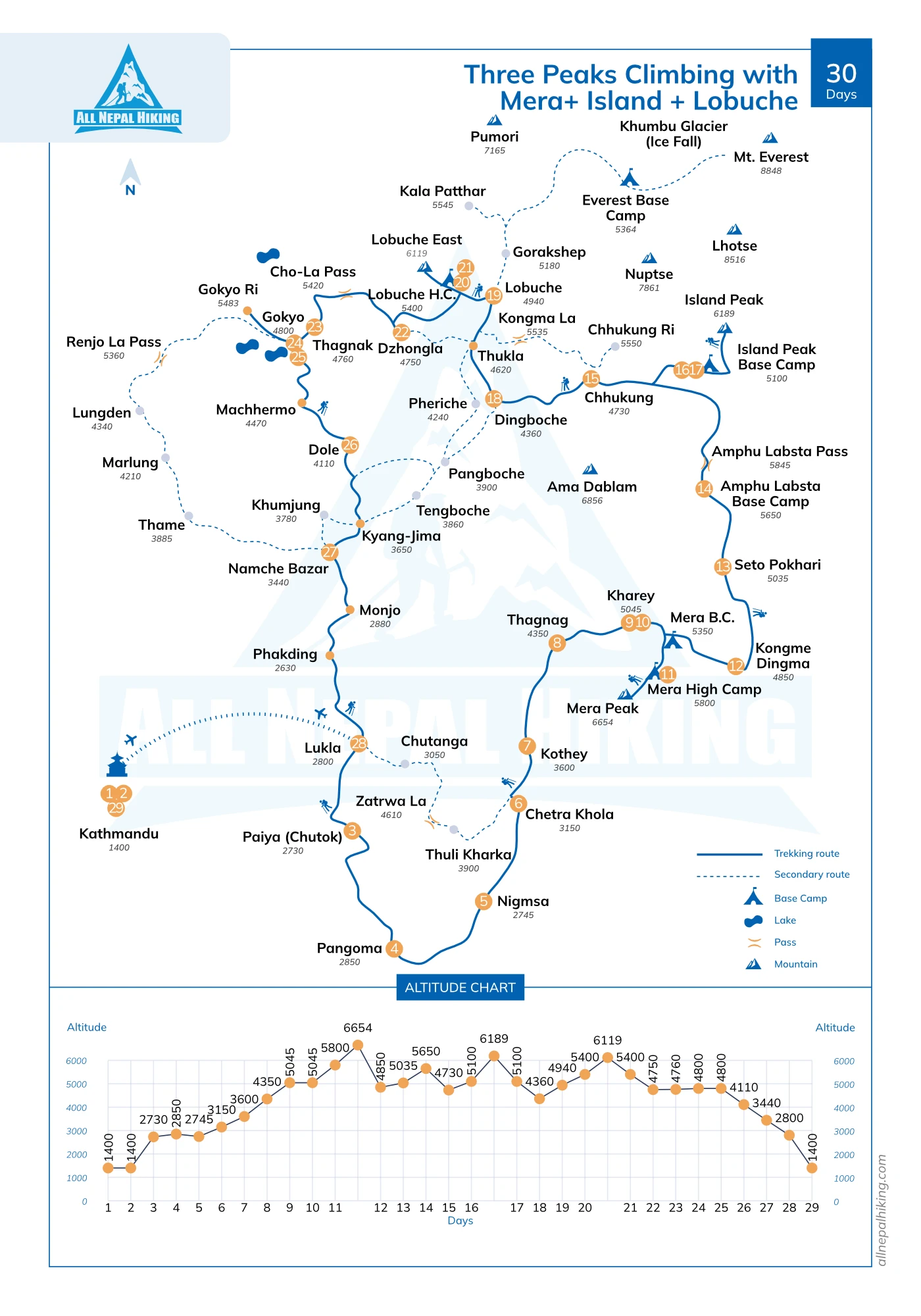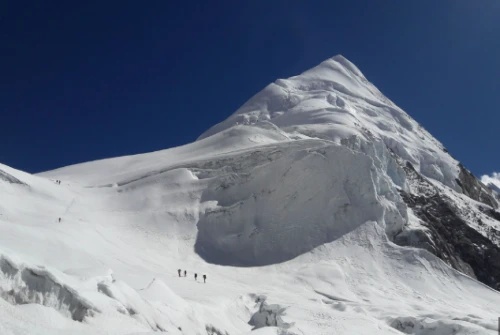Mera ,Island and Lobuche Peak Climbing is a thrilling Himalayan mountaineering expedition that takes you to the summit of three of the most popular 6,000-meter class mountains in Nepal’s Khumbu region. This exciting climbing adventure involves conquering Mera Peak (6,461 meters/21,192 feet), Island Peak (6,189 meters/20,299 feet), and Lobuche Peak (6,119 meters/20,070 feet) all in a single expedition itinerary. Along the way, climbers will experience some of the most scenic and remote areas of Nepal, trekking through the iconic Khumbu Valley and the more secluded, wild sections of the Honku Valley.
This three-peak climbing expedition is an excellent opportunity for climbers looking to sharpen their mountaineering skills on semi-technical slopes, all while acclimatizing to higher altitudes in preparation for larger expeditions. By summiting Mera Peak, the highest trekking peak in Nepal, followed by Island Peak and Lobuche Peak, climbers gain a well-rounded experience, handling both easier and more technical sections. These peaks provide a perfect mix of introductory challenges, making them ideal for climbers aiming to tackle Himalayan mountaineering before attempting 8,000-meter class expeditions.
The well-crafted itinerary of this three-peak climb has been designed with careful consideration for the difficulty levels of each peak and the critical need for proper acclimatization. Starting with Mera Peak, you’ll gradually progress to Island Peak and Lobuche Peak, allowing for a natural progression in technical difficulty while ensuring ample time for rest and acclimatization. This expedition includes contingency days to ensure you have a safe and comfortable climbing experience.
Climbers will benefit from a fully guided expedition, with experienced mountaineering guides providing all the necessary support, including equipment, route guidance, and safety measures. This ensures you can tackle the semi-technical segments with confidence, while immersing yourself in the stunning landscapes of the Khumbu and Honku valleys.
The Three Peaks Climb in Nepal: A Comprehensive Himalayan Mountaineering Adventure
The Three Peaks Climb in Nepal is the perfect introduction to Himalayan mountaineering, offering climbers the opportunity to conquer three of the region’s iconic 6,000-meter peaks in one expedition. This exciting challenge allows you to summit Mera Peak, Island Peak (Imja Tse), and Lobuche Peak, giving you a true taste of high-altitude mountaineering and an unforgettable experience in the heart of the Himalayas.
Mera Peak (6,470m): The Highest Trekking Peak in Nepal
At 6,470 meters, Mera Peak is the highest trekking peak in Nepal, located in the Mahalangur Range of the eastern Himalayas, southeast of Mount Everest. Known for its non-technical climb, Mera Peak provides an excellent introduction to Himalayan mountaineering, with stunning panoramic views of Mount Everest, Makalu, Lhotse, Cho Oyu, Kanchenjunga, and several other towering peaks. The best seasons to climb Mera Peak are spring (March to May) and autumn (September to November), when the weather is clear, and the conditions are ideal for trekking and climbing.
Island Peak (Imja Tse, 6,189m): A Moderate Challenge for Beginners
Island Peak (6,189m), also known as Imja Tse, was named by English mountaineer Eric Shipton in 1953 because its summit, when viewed from Dingboche, resembles an island in a sea of ice. In 1983, the peak was officially renamed Imja Tse. Known for its moderate technical difficulty, Island Peak is a popular choice for climbers looking to take on a more challenging trekking peak. It’s an excellent option for climbers with good endurance and a desire to take on semi-technical climbing. With its beautiful views of the surrounding peaks and accessible difficulty, Island Peak attracts hundreds of climbers each year, making it a top destination in the Khumbu region.
Lobuche Peak (6,119m/6,145m): A Scenic and Technically Challenging Summit
Lobuche Peak features two summits—East (6,119m) and West (6,145m)—separated by a sharp and scenic ridge. The East Peak is considered a trekking peak, while the West Peak is more suited for expedition-level climbers. Lobuche Peak is renowned for its striking appearance and offers one of the most dramatic climbing routes in the Khumbu region. The climb along the South Ridge rising above the Khumbu Glacier is especially scenic, making it a highly sought-after peak among climbers. With several established routes and potential for new climbs, Lobuche is a favorite for those seeking a more technical challenge amidst breathtaking mountain scenery.
Everest Base Camp Trek: A Gateway to the Roof of the World
The Everest Base Camp (EBC) Trek is an iconic adventure that takes trekkers to the heart of the Khumbu Valley and offers jaw-dropping views of Mount Everest—the world’s highest peak. Although not a part of the Three Peaks Climb itself, EBC is often included in the journey, providing an unparalleled trekking experience. The trek offers a unique opportunity to witness the grandeur of Everest up close, while passing through traditional Sherpa villages, stunning monasteries, and serene mountain landscapes. It’s a journey that connects trekkers to the spirit of the Himalayas and the awe-inspiring natural beauty of the Everest region.
Highlights of the Mera, Island, and Lobuche Peak Climbing Expedition
Mera Peak: The Highest Trekking Peak in Nepal
Highest Trekking Peak in Nepal: Standing at an impressive 6,476 meters (21,247 feet), Mera Peak is the highest trekking peak in Nepal. Climbing Mera offers climbers a sense of accomplishment, with stunning views of Mount Everest, Makalu, Cho Oyu, Kanchenjunga, and other towering Himalayan peaks.
Diverse Landscapes: The journey to Mera Peak takes climbers through a variety of landscapes, including lush forests, picturesque valleys, and high-altitude terrain. The route showcases the natural beauty of the Himalayas, offering a captivating experience.
Remote and Less-Crowded: Unlike the popular Everest Base Camp trek, Mera Peak offers a more off-the-beaten-path adventure. Climbers get to explore remote Sherpa villages, engage with the region’s unique culture, and enjoy the tranquility of the high mountains.
Island Peak (Imja Tse): A Challenging Technical Climb
Stunning Panoramic Views: At 6,189 meters (20,305 feet), Island Peak (Imja Tse) offers breathtaking 360-degree views of the surrounding Himalayan peaks, including Lhotse, Ama Dablam, Makalu, and more. The summit provides an awe-inspiring vantage point to witness the grandeur of the Everest region.
Technical Challenge: Climbing Island Peak requires technical mountaineering skills, including the use of crampons, ropes, and ice axes. The climb includes crossing glaciated terrain and ascending steep ice slopes, making it a thrilling challenge for experienced climbers.
Himalayan Achievement: Reaching the summit of Island Peak is a significant mountaineering achievement, allowing climbers to celebrate their mountaineering prowess and enjoy the stunning views as a reward for their hard work.
Lobuche Peak: A True Himalayan Expedition
Technical Mountaineering: Lobuche Peak, with two summits—East (6,119 meters / 20,075 feet) and West (6,145 meters / 20,160 feet)—presents a true technical climbing challenge. The route involves glacier crossings, navigating steep slopes, and climbing a final ridge to the summit, making it a demanding but rewarding expedition.
Majestic Summit Views: The summit of Lobuche Peak offers breathtaking panoramic views of Everest, Lhotse, Nuptse, and several other towering peaks in the Khumbu region. The vistas from the summit are sure to leave a lasting impression on every climber.
Off the Beaten Path: By bypassing the traditional Everest Base Camp trek and returning via the Gokyo Cho La Pass, climbers enjoy a more remote, adventurous route that provides a unique perspective of the region, far from the usual crowds.
Gokyo Cho La Pass: A Scenic High-Altitude Pass
Scenic Mountain Pass: The Gokyo Cho La Pass (5,420m) connects the Gokyo Valley with the Khumbu Valley. Crossing this high-altitude pass provides climbers with panoramic views of the surrounding peaks and glaciers, adding a sense of adventure and exploration to the journey.
Gokyo Lakes: Along the route, climbers have the chance to visit the Gokyo Lakes, a stunning series of glacial lakes known for their turquoise waters. These serene lakes add an extra layer of beauty to the expedition and offer fantastic photo opportunities.
Unique Perspective: Returning via the Gokyo Cho La Pass offers climbers a different perspective of the Everest region, taking them through remote valleys and offering new viewpoints on the towering peaks, including Everest and Makalu.
Why Choose the Three Peaks Climb in Nepal?
- Conquer Three Iconic Peaks: Climb Mera Peak, Island Peak, and Lobuche Peak, three of the most sought-after trekking peaks in Nepal.
- Moderate Difficulty: The expedition is designed to be an excellent introduction to Himalayan mountaineering, combining non-technical peaks like Mera with more technical climbs on Island and Lobuche Peak.
- Stunning Views: Experience unmatched panoramic views of the world's tallest peaks, including Everest, Lhotse, Makalu, Cho Oyu, and Kanchenjunga.
- Fully Guided: A fully guided expedition ensures safety and support, with experienced climbers leading the way and providing essential equipment.
- Acclimatization and Safety: The climb is designed with built-in acclimatization days, ensuring a safe and successful summit of each peak.
Expedition Difficulty: Climbing Mera Peak, Island Peak, and Lobuche Peak
Climbing Mera Peak, Island Peak, and Lobuche Peak presents an exhilarating yet moderate difficulty Himalayan adventure, ideal for those looking to tackle some of the most popular 6,000-meter trekking peaks in the Everest region. These peaks provide an accessible challenge for climbers with basic mountaineering experience, while still offering a taste of the technical climbs found in the Himalayas.
Mera Peak: A Non-Technical Trekking Peak
At 6,476 meters (21,247 feet), Mera Peak is the highest trekking peak in Nepal. It is classified as a non-technical climb, making it an excellent starting point for climbers new to high-altitude expeditions. Mera Peak is perfect for those who are looking to experience Himalayan climbing without tackling technical rock or ice sections. Although the altitude and weather conditions can still pose challenges, the climb itself is straightforward, requiring no advanced mountaineering skills.
Island Peak and Lobuche Peak: A Step Up in Technical Challenge
While Mera Peak offers an introductory experience, Island Peak (6,189 meters) and Lobuche Peak (6,119 meters) introduce more technical aspects of mountaineering, including the use of crampons, ice axes, and ropes. These peaks require climbers to tackle glacier crossings, steep ice slopes, and fixed ropes, making them suitable for beginners with basic mountaineering skills. Island Peak, in particular, involves navigating glaciated terrain, while Lobuche requires ridge climbing in a rugged environment.
Island Peak is a semi-technical climb and is considered one of the best mountains for beginner mountaineers looking to take on their first technical peak. Climbers will use fixed ropes and learn to manage their gear in high-altitude conditions.
Lobuche Peak, while also a trekking peak, demands a bit more from climbers with its glacier crossings and steep, rocky sections. Its more challenging technical climb will push climbers to their limits, requiring them to have basic knowledge of mountaineering techniques.
Fully Guided Expedition for Safety and Support
This expedition is fully guided, ensuring safety and expert support every step of the way. Whether you’re climbing Mera Peak to kick-start your mountaineering journey or tackling the more technical sections of Island Peak and Lobuche Peak, your experienced guides will provide the necessary guidance, logistics, and safety measures. Your climbing crew will handle all arrangements, from gear and equipment to route management, so you can focus on the climb itself and the incredible views of the Himalayan mountains.





 based on 1 review
based on 1 review